Mr Smith Goes to Washington
8.8 /10 1 Votes8.8
94% Rotten Tomatoes Genre Drama Country United States | 8.3/10 IMDb Duration Language English | |||||||||||||||||||||||||||||||||
 | ||||||||||||||||||||||||||||||||||
Release date October 17, 1939 (1939-10-17) Initial release October 17, 1939 (Washington, D.C.) Awards Academy Award for Best Story Cast (Clarissa Saunders), (Jefferson Smith), (Sen. Joseph Harrison Paine), (Jim Taylor), (Gov. Hubert 'Happy' Hopper), (Diz Moore) Similar movies Captain America: The Winter Soldier , Democracy Is ... , The Masters of Terror , Star Wars: Episode I - The Phantom Menace , Rendition , Star Wars: Episode II - Attack of the Clones Tagline Romance, drama, laughter and heartbreak... created out of the very heart and soil of America! | ||||||||||||||||||||||||||||||||||
Mr smith goes to washington full movie 1939
Mr. Smith Goes to Washington is a 1939 American political comedy-drama film directed by Frank Capra, starring Jean Arthur and James Stewart, and featuring Claude Rains and Edward Arnold. The film is about a newly appointed United States Senator who fights against a corrupt political system, and was written by Sidney Buchman, based on Lewis R. Foster's unpublished story "The Gentleman from Montana". The film was controversial when it was first released, but was also successful at the box office, and made Stewart a major movie star.
Contents
- Mr smith goes to washington full movie 1939
- Mr smith goes to washington filibuster
- Plot
- Cast
- Production
- Impact
- Academy Awards
- Other honors
- Remakes
- In popular culture
- References

Mr. Smith Goes to Washington was nominated for eleven Academy Awards, winning for Best Original Story. Considered to be one of the greatest films of all time, the film was selected by the Library of Congress for preservation in the United States National Film Registry in 1989, deeming it "culturally, historically, or aesthetically significant".

Mr smith goes to washington filibuster
Plot
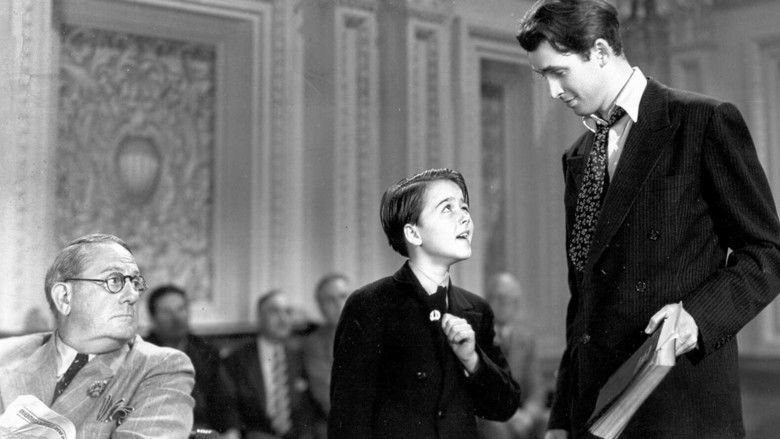
The governor of an unnamed western state, Hubert "Happy" Hopper (Guy Kibbee), has to pick a replacement for recently deceased U.S. Senator Sam Foley. His corrupt political boss, Jim Taylor (Edward Arnold), pressures Hopper to choose his handpicked stooge, while popular committees want a reformer, Henry Hill. The governor's children want him to select Jefferson Smith (James Stewart), the head of the Boy Rangers. Unable to make up his mind between Taylor's stooge and the reformer, Hopper decides to flip a coin. When it lands on edge – and next to a newspaper story on one of Smith's accomplishments – he chooses Smith, calculating that his wholesome image will please the people while his naïveté will make him easy to manipulate.
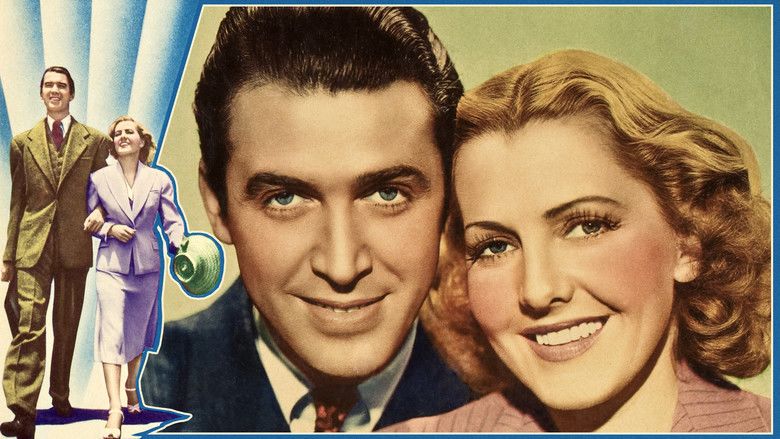
Junior Senator Smith is taken under the wing of the publicly esteemed, but secretly crooked, Senator Joseph Paine (Claude Rains), who was Smith's late father's friend. Smith develops an immediate attraction to the senator's daughter, Susan (Astrid Allwyn). At Senator Paine's home, Smith has a conversation with Susan, fidgeting and bumbling, entranced by the young socialite. Smith's naïve and honest nature allows the unforgiving Washington press to take advantage of him, quickly tarnishing Smith's reputation with ridiculous front page pictures and headlines branding him a bumpkin.
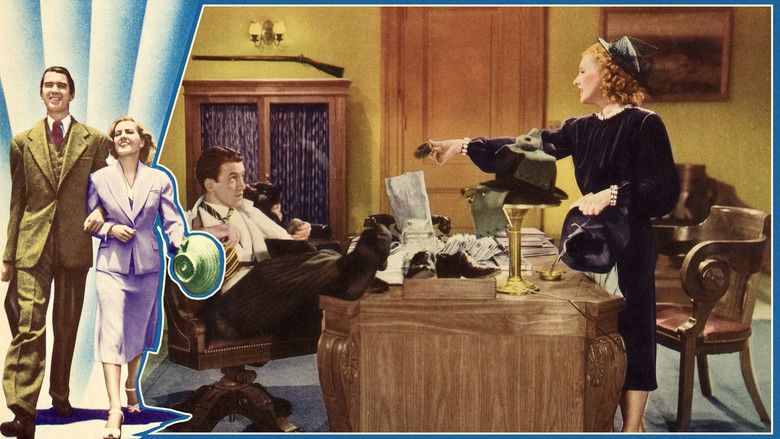
To keep Smith busy, Paine suggests he propose a bill. With the help of his secretary, Clarissa Saunders (Jean Arthur), who was the aide to Smith's predecessor and had been around Washington and politics for years, Smith comes up with a bill to authorize a federal government loan to buy some land in his home state for a national boys' camp, to be paid back by youngsters across America. Donations pour in immediately. However, the proposed campsite is already part of a dam-building graft scheme included in an appropriations bill framed by the Taylor political machine and supported by Senator Paine.
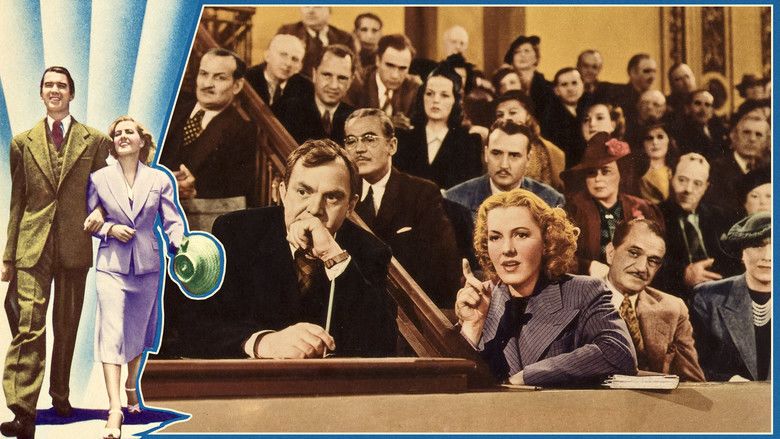
Unwilling to crucify the worshipful Smith so that their graft plan will go through, Paine tells Taylor he wants out, but Taylor reminds him that Paine is in power primarily through Taylor's influence. Through Paine, the machine in his state accuses Smith of trying to profit from his bill by producing fraudulent evidence that Smith already owns the land in question. Smith is too shocked by Paine's betrayal to defend himself, and runs away.
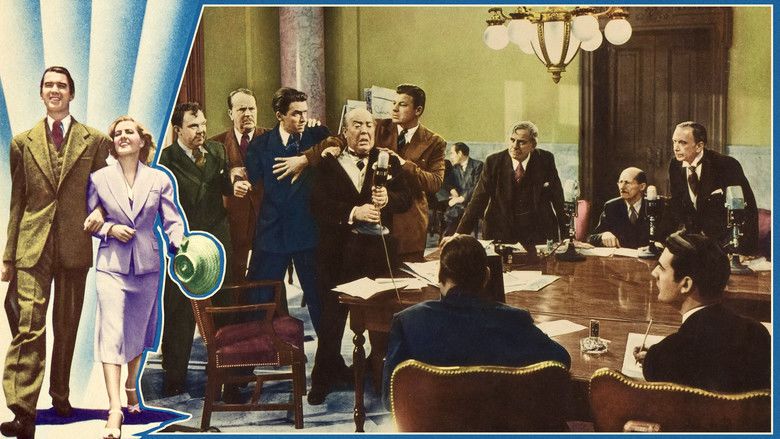
Saunders, who looked down on Smith at first, but has come to believe in him, talks him into launching a filibuster to postpone the appropriations bill and prove his innocence on the Senate floor just before the vote to expel him. In his last chance to prove his innocence, he talks non-stop for about 24 hours, reaffirming the American ideals of freedom and disclosing the true motives of the dam scheme. Yet none of the Senators are convinced.
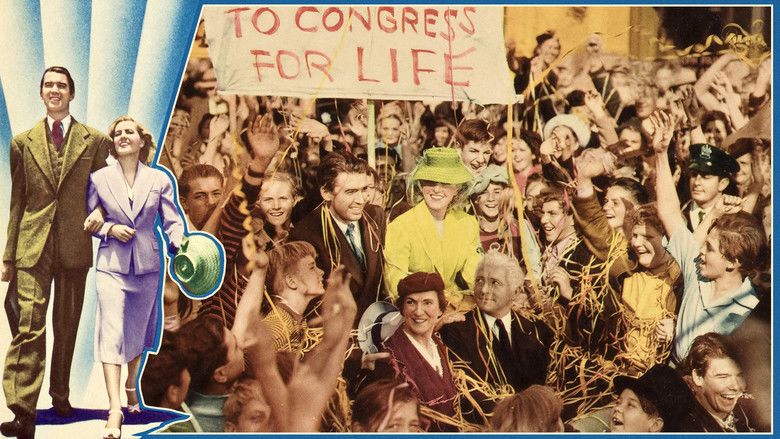
The constituents try to rally around him, but the entrenched opposition is too powerful, and all attempts are crushed. Owing to the influence of Taylor's machine, newspapers and radio stations in Smith's home state, on Taylor's orders, refuse to report what Smith has to say and even distort the facts against the senator. An effort by the Boy Rangers to spread the news in support of Smith results in vicious attacks on the children by Taylor's minions.
Although all hope seems lost, the senators begin to pay attention as Smith approaches utter exhaustion. Paine has one last card up his sleeve: he brings in bins of letters and telegrams from Smith's home state, purportedly from average people demanding his expulsion. Nearly broken by the news, Smith finds a small ray of hope in a friendly smile from the President of the Senate (Harry Carey). Smith vows to press on until people believe him, but immediately collapses in a faint. Overcome with guilt, Paine leaves the Senate chamber and attempts to commit suicide by gunshot, but is stopped by onlooking senators. He then bursts back into the Senate chamber, shouting a confession to the whole scheme; Paine further insists that he should be expelled from the Senate and affirms Smith's innocence, to the delight of Clarissa. The President of the Senate observes the ensuing chaos with amusement.
Cast
Cast notes:
Production
Columbia Pictures originally purchased Lewis R. Foster's unpublished story, variously called "The Gentleman from Montana" and "The Gentleman from Wyoming", as a vehicle for Ralph Bellamy, but once Frank Capra came on board as director – after Rouben Mamoulian had expressed interest – the film was to be a sequel to his Mr. Deeds Goes to Town, called Mr. Deeds Goes to Washington, with Gary Cooper reprising his role as Longfellow Deeds. Because Cooper was unavailable, Capra then "saw it immediately as a vehicle for Jimmy Stewart and Jean Arthur", and Stewart was borrowed from MGM. Capra said of Stewart: "I knew he would make a hell of a Mr. Smith ... He looked like the country kid, the idealist. It was very close to him."
Although a youth group is featured in the story, the Boy Scouts of America refused to allow their name to be used in the film and instead the fanciful "Boy Rangers" was used.
In January 1938, both Paramount Pictures and MGM had submitted Foster's story to the censors at the Hays Office, probably indicating that both studios had interest in the project before Columbia purchased it. Joseph Breen, the head of that office, warned the studios: "[W]e would urge most earnestly that you take serious counsel before embarking on the production of any motion picture based on this story. It looks to us like one that might well be loaded with dynamite, both for the motion picture industry, and for the country at large." Breen specifically objected to "the generally unflattering portrayal of our system of Government, which might well lead to such a picture being considered, both here, and more particularly abroad, as a covert attack on the Democratic form of government", and warned that the film should make clear that "the Senate is made up of a group of fine, upstanding citizens, who labor long and tirelessly for the best interests of the nation ..."
Later, after the screenplay had been written and submitted, Breen reversed course, saying of the film, "It is a grand yarn that will do a great deal of good for all those who see it and, in my judgment, it is particularly fortunate that this kind of story is to be made at this time. Out of all Senator Jeff's difficulties there has been evolved the importance of a democracy and there is splendidly emphasized the rich and glorious heritage which is ours and which comes when you have a government 'of the people, by the people, and for the people'".
The film was in production from April 3, 1939, to July 7 of that year. Some location shooting took place in Washington, D.C., at Union Station and at the United States Capitol, as well as other locations for background use.
In the studio, to ensure authenticity, an elaborate set was created, consisting of Senate committee rooms, cloak rooms, and hotel suites, as well as specific Washington, D.C., monuments, all based on a trip Capra and his crew made to the capital. Even the Press Club of Washington was reproduced in minute detail, but the major effort went into a faithful reproduction of the Senate Chamber on the Columbia lot. James D. Preston, a former superintendent of the Senate gallery, acted as technical director for the Senate set, as well as advising on political protocol. The production also utilized the "New York street set" on the Warner Bros. lot, using 1,000 extras when that scene was shot.
The ending of the film was apparently changed at some point, as the original program describes Stewart and Arthur returning to Smith's hometown, where they are met by a big parade, with the implication that they are married and starting a family. In addition, the Taylor political machine is shown being crushed; Smith, riding a motorcycle, visits Senator Paine and forgives him; and a visit to Smith's mother is included. Some of this footage can be seen in the film's trailer.
Impact
The film premiered in Constitution Hall in Washington, D.C., on October 17, 1939, sponsored by the National Press Club, an event to which 4,000 guests were invited, including 45 senators. Mr. Smith Goes to Washington was attacked by the Washington press, and politicians in the U.S. Congress, as anti-American and pro-Communist for its portrayal of corruption in the American government. While Capra claims in his autobiography that some senators walked out of the premiere, contemporary press accounts are unclear about whether this occurred or not, or whether senators yelled back at the screen during the film.
It is known that Alben W. Barkley, a Democrat and the Senate Majority Leader, called the film "silly and stupid", and said it "makes the Senate look like a bunch of crooks". He also remarked that the film was "a grotesque distortion" of the Senate, "as grotesque as anything ever seen! Imagine the Vice President of the United States winking at a pretty girl in the gallery in order to encourage a filibuster!" Barkley thought the film "... showed the Senate as the biggest aggregation of nincompoops on record!"
Pete Harrison, a respected journalist and publisher of the motion picture trade journal Harrison's Reports, suggested that the Senate pass a bill allowing theater owners to refuse to show films that "were not in the best interest of our country". That did not happen, but one of the ways that some senators attempted to retaliate for the damage they felt the film had done to the reputation of their institution was by pushing the passage of the Neely Anti-Block Booking Bill, which eventually led to the breakup of the studio-owned theater chains in the late 1940s. Columbia responded by distributing a program which put forward the film’s patriotism and support of democracy and publicized the film’s many positive reviews.
Other objections were voiced as well. Joseph P. Kennedy, the American Ambassador to Great Britain, wrote to Capra and Columbia head Harry Cohn to say that he feared the film would damage "America’s prestige in Europe", and because of this urged that it be withdrawn from European release. Capra and Cohn responded, citing the film’s review, which mollified Kennedy to the extent that he never followed up, although he privately still had doubts about the film.
The film was banned in Hitler's Germany, Mussolini's Italy, Franco's Spain and Stalin's USSR. According to Capra, the film was also dubbed in certain European countries to alter the message of the film so it conformed with official ideology.
When a ban on American films was imposed in German occupied France in 1942, some theaters chose to show Mr. Smith Goes to Washington as the last movie before the ban went into effect. One theater owner in Paris reportedly screened the film nonstop for 30 days after the ban was announced.
The critical response to the film was more measured than the reaction by politicians, domestic and foreign. The critic for The New York Times, for instance, Frank S. Nugent, wrote that "[Capra] is operating, of course, under the protection of that unwritten clause in the Bill of Rights entitling every voting citizen to at least one free swing at the Senate. Mr. Capra’s swing is from the floor and in the best of humor; if it fails to rock the august body to its heels – from laughter as much as from injured dignity – it won’t be his fault but the Senate's, and we should really begin to worry about the upper house."
Mr. Smith Goes to Washington has been called one of the quintessential whistleblower films in American history. Dr. James Murtagh and Dr. Jeffrey Wigand cited this film as a seminal event in U.S. history at the first "Whistleblower Week in Washington" (May 13–19, 2007).
Mr. Smith Goes to Washington has often been listed as among Capra’s best, but it has been noted that it "marked a turning point in Capra’s vision of the world, from nervous optimism to a darker, more pessimistic tone. Beginning with American Madness (1932), such Capra films as Lady for a Day (1933), It Happened One Night (1934), Mr. Deeds Goes to Town (1936), and You Can’t Take It With You (1938) had trumpeted their belief in the decency of the common man. In Mr. Smith Goes to Washington, however, the decent common man is surrounded by a venal, petty and thuggish group of crooks. Everyone in the film – except for Jefferson Smith and his tiny cadre of believers – is either in the pay of the political machine run by Edward Arnold’s James Taylor or complicit in Taylor’s corruption through their silence, and they all sit by as innocent people, including children, are brutalized and intimidated, rights are violated, and the government is brought to a halt".
Nevertheless, Smith’s filibuster and the tacit encouragement of the Senate President are both emblematic of the director's belief in the difference that one individual can make. This theme would be expanded further in Capra's It's a Wonderful Life (1946) and other films.
Academy Awards
Mr. Smith Goes to Washington was nominated for 11 Academy Awards but won only one.
Other honors
Remakes
In popular culture
References
Mr. Smith Goes to Washington WikipediaMr. Smith Goes to Washington IMDbMr. Smith Goes to Washington Rotten TomatoesMr Smith Goes to Washington themoviedb.org
